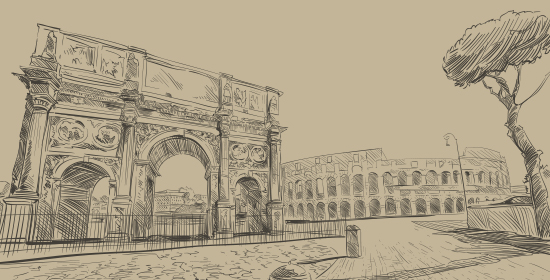Exploring the Eternal City: The 7 Must-See Squares in Rome

PRO TIP: Searching for the Must-See Squares in Rome? Save this article in your browser's "Rome Travel" folder for easy reference during your trip planning. For an unparalleled experience in a historically rich city like Rome, discover our top-rated Rome tours and Rome Shore Excursions from Civitavecchia for a luxurious and comfortable exploration of the Eternal City.
Buongiorno and welcome to Stefano’s RomeCabs! Rome, the Eternal City, is a treasure trove of history, culture, and architectural wonders. One of the best ways to immerse yourself in the essence of Rome is by strolling through its iconic squares. Each square, or "piazza" in Italian, has a unique charm and a story to tell, and there are so many must-see squares in Rome.
In this blog, we'll take you on a virtual tour of the 7 must-see squares in Rome, where history comes alive, and the heartbeat of the city echoes through the cobblestone streets.
The 7 Must-See Squares in Rome
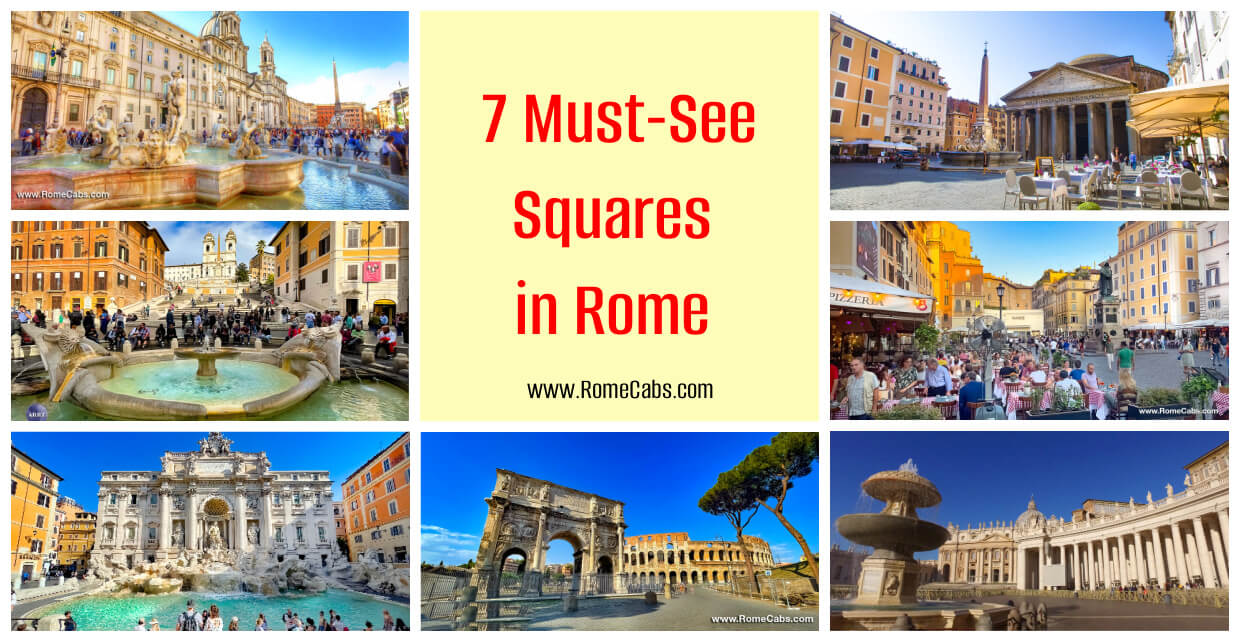
1. Piazza Navona
Piazza Navona, a jewel in the crown of Rome's historic landscape, stands as a testament to the city's artistic and architectural prowess. Nestled in the heart of Rome, this grand square has evolved from the ancient Stadium of Domitian into a vibrant gathering place that beautifully showcases the Baroque era's artistic brilliance.
Piazza Navona's Architectural Splendor
The distinctive oval shape of Piazza Navona is not merely a stylistic choice but a fascinating nod to the historical evolution of the space. The square's elongated form takes its shape from the previous Stadium of Domitian, which once stood on the same site. This ancient stadium, commissioned by Emperor Domitian in the 1st century AD, was a grand venue primarily used for athletic contests and competitions.
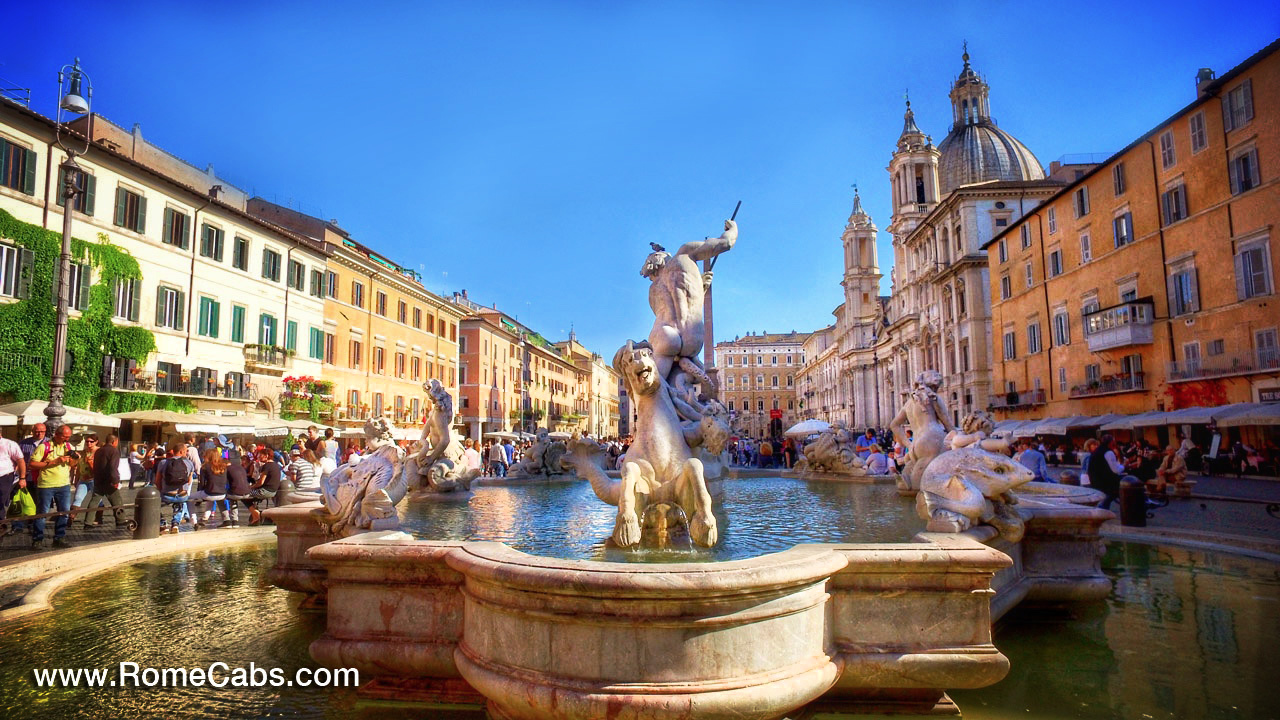
The elliptical layout of the original stadium has left an indelible mark on Piazza Navona's current configuration. As Rome evolved over the centuries, the stadium fell into disuse and disrepair. However, instead of being completely dismantled, its basic shape persisted, influencing the design of the modern square that we see today.
During the 17th century, a period renowned for its artistic and architectural innovation, Piazza Navona underwent a significant transformation under the guidance of eminent architects, including the likes of Gian Lorenzo Bernini and Francesco Borromini. These visionaries incorporated the existing oval shape into their designs, embracing the historical continuity and celebrating Rome's layered past.
The result is a unique blend of Baroque aesthetics with a nod to classical antiquity. The elongated oval provides a dynamic and harmonious space that facilitates a fluid movement of people, creating an inviting atmosphere for gatherings and events. The surrounding buildings, once palatial residences of the city's elite, contribute to the overall architectural splendor of the square, framing it with a sense of grandeur and sophistication.
Bernini's Fountain of the Four Rivers
At the heart of Piazza Navona lies Bernini's Fountain of the Four Rivers, a masterpiece that encapsulates the grandeur of Baroque sculpture. Designed by Gian Lorenzo Bernini in 1651, the fountain represents four major rivers from four different continents – the Nile, Ganges, Danube, and Rio de la Plata.
Each river deity is skillfully sculpted in a dynamic pose, supporting an Egyptian obelisk. The fountain's intricate details and dynamic composition make it a captivating centerpiece, drawing crowds to marvel at its artistic grandeur.
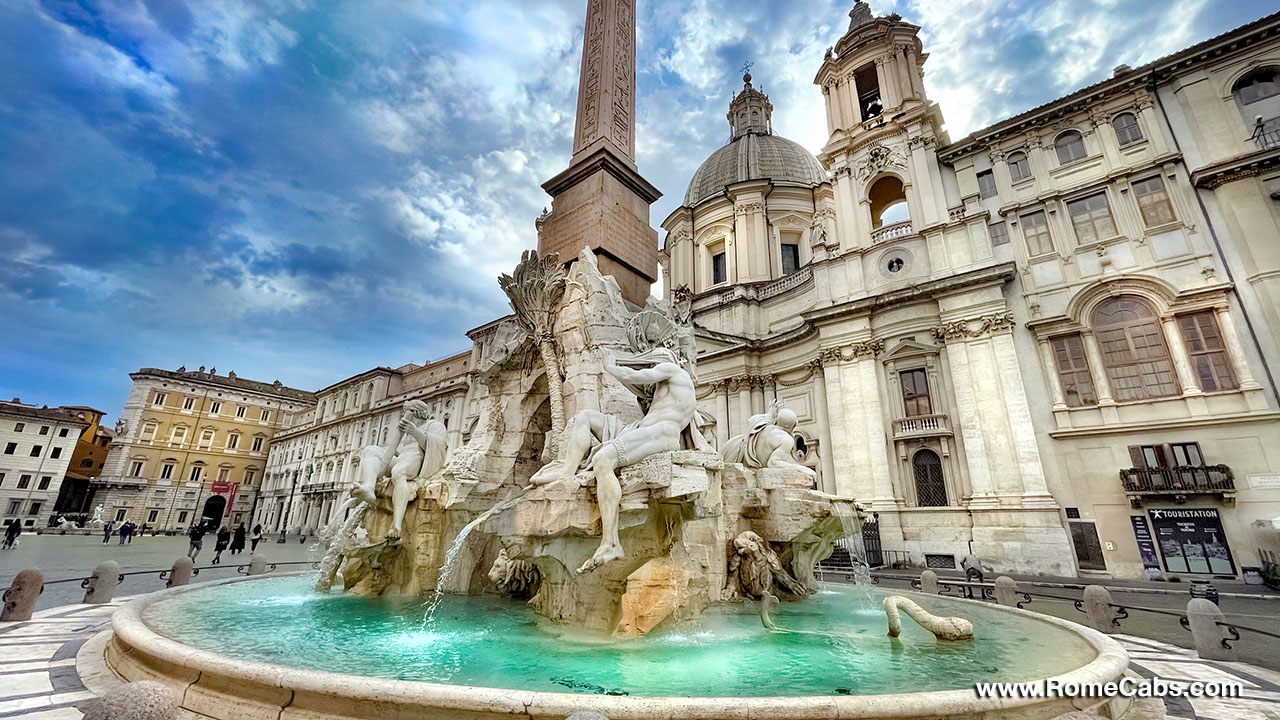
Sant'Agnese in Agone Church
Dominating one side of Piazza Navona is the stunning Sant'Agnese in Agone church (as you can see in the photo above). Designed by Francesco Borromini and Girolamo Rainaldi, this Baroque church is dedicated to Saint Agnes and stands on the site where, according to legend, she faced persecution. The church's façade is adorned with intricate details and sculptures, contributing to the square's overall aesthetic appeal. Visitors can step inside to explore its ornate interior and soak in the religious and historical significance of this architectural gem.
Street Life and Cafés in Piazza Navona
Piazza Navona is not just a static architectural wonder; it's a lively hub of activity. Cafés and restaurants line the perimeter, offering visitors a chance to savor Italian cuisine while basking in the vibrant atmosphere. From street performers showcasing their talents to local artists displaying their works, the square pulsates with life throughout the day. This lively ambiance makes it an ideal spot for leisurely strolls, people-watching, and immersing oneself in the Roman way of life.
- TOUR TIP: You can enjoy Piazza Navona on our Panoramic Rome Tour, Panoramic Rome for Cruisers, and our Post-Cruise Panoramic Rome Tour from Civitavecchia.
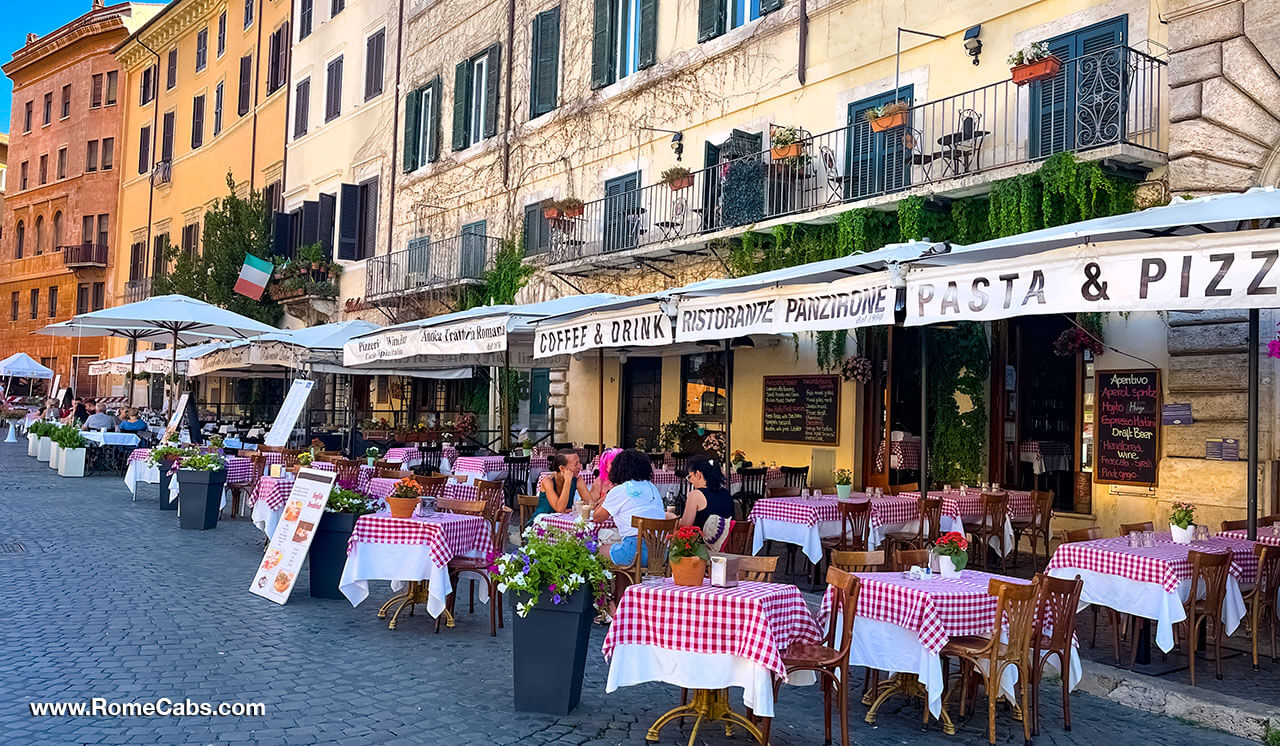
2. Piazza della Rotonda
Located in the historical center of Rome, Piazza della Rotonda is an enchanting square that revolves around one of the city's most iconic monuments—the Pantheon. The square takes its name from the Pantheon's original title, the Basilica di Santa Maria ad Martyrs.
The lively atmosphere attracts both locals and tourists, making it an ideal spot for leisurely strolls and impromptu gatherings. The square's vibrant ambiance perfectly complements the timeless beauty of the Pantheon and creates a dynamic space that continues to evolve through the ages.
Admire the Ancient Roman Marvel - The Pantheon
Dominating the square, the Pantheon stands as a testament to Roman engineering and architectural brilliance. Originally built by Emperor Agrippa in 27 B.C. and later rebuilt by Emperor Hadrian around 120 A.D., the Pantheon's grandeur lies in its monumental dome and perfectly proportioned portico.
The portico features sixteen massive Corinthian columns, each hewn from a single block of Egyptian granite, showcasing the unparalleled craftsmanship of ancient Rome. The Pantheon's enduring legacy as a place of worship and intellectual contemplation adds a spiritual and historical layer to Piazza della Rotonda.

Cafés and Al Fresco Dining in Piazza della Rotonda
Surrounding the Pantheon, Piazza della Rotonda boasts a collection of charming cafés and restaurants. Visitors can indulge in the quintessential Roman experience of sipping espresso or enjoying a leisurely meal while marveling at the architectural splendor of the Pantheon. The al fresco dining options create a convivial atmosphere, inviting guests to savor both the culinary delights and the visual feast of ancient and modern Rome.
Fountain and Egyptian Obelisk
At the center of Piazza della Rotonda, a charming fountain designed by Giacomo Della Porta takes center stage. The fountain, known as the Fontana del Pantheon, features an ancient Egyptian obelisk as its centerpiece. The obelisk, originally located in the Iseum Campense, was later moved to its current location by Pope Clement XI in 1711. The fountain and obelisk contribute to the square's harmonious aesthetic, adding an element of grandeur and historical continuity.
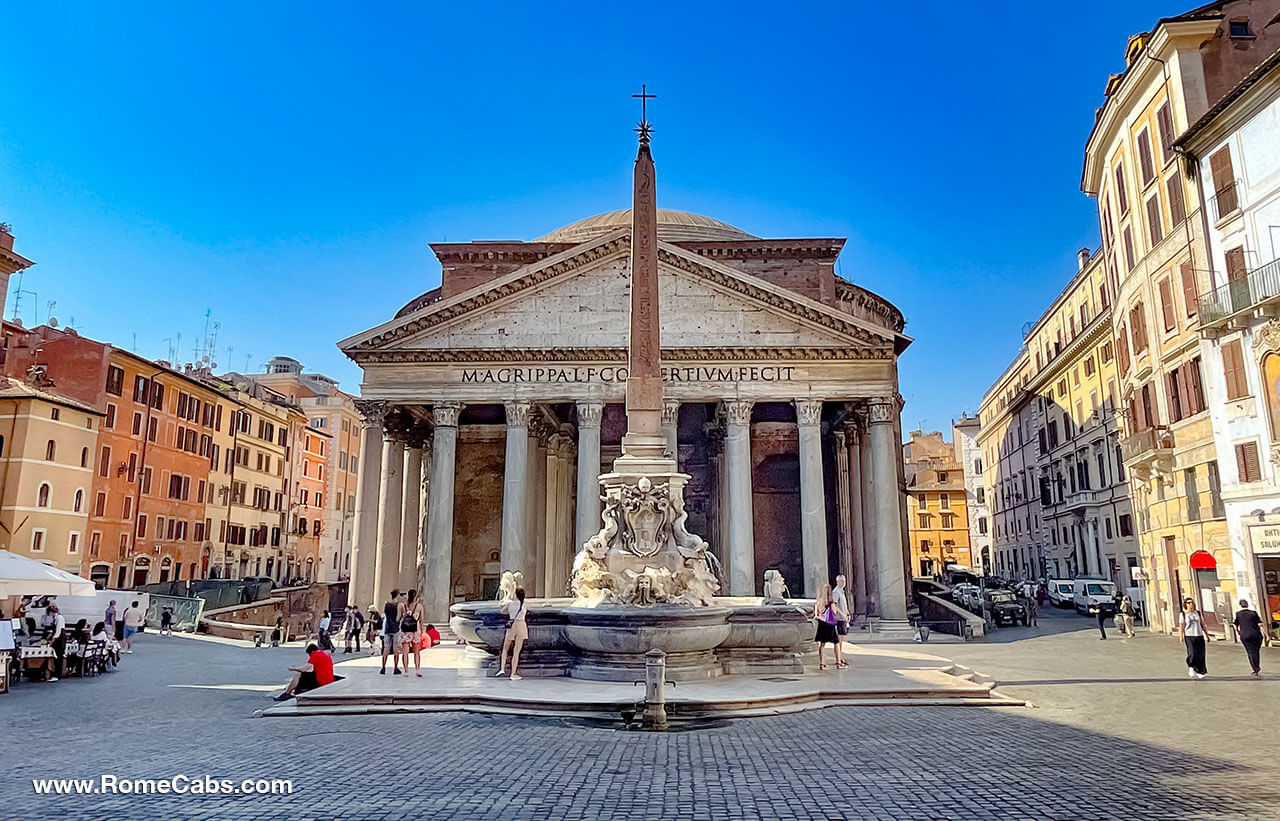
Nighttime Magic:
As the sun sets and the lights illuminate the Pantheon, Piazza della Rotonda undergoes a magical transformation. The nocturnal atmosphere adds a touch of mystery to the square, and the Pantheon's dome glows ethereally, casting a mesmerizing aura over the entire area. Nighttime visits to Piazza della Rotonda offer a unique perspective on the Pantheon's magnificence, creating an unforgettable experience for those seeking a romantic or contemplative ambiance.
Piazza della Rotonda stands as a living testament to the resilience of Rome's ancient heritage. It's a space where history, art, and contemporary life intersect, inviting visitors to immerse themselves in the grandeur of the Pantheon and the timeless allure of one of the world's most captivating squares.
- Relish a stop in Piazza della Rotonda on our Tour Rome as Romans Do which takes you on a delightful “la dolce vita” tour of Rome.
3. Piazza di Spagna
Piazza di Spagna, situated at the base of the iconic Spanish Steps, is not just a square; it's a cultural crossroads that beautifully blends history, art, and modern sophistication. The name "Piazza di Spagna" originates from the nearby Spanish Embassy to the Holy See, establishing a connection between the square and the Spanish presence in Rome.

Fontana della Barcaccia in Piazza di Spagna
At the base of the Spanish Steps, Fontana della Barcaccia (loosely translated as the Fountain of the Old Boat) adds a touch of whimsy and charm to Piazza di Spagna. Designed by Gian Lorenzo Bernini's father, Pietro Bernini, in the early 17th century, the fountain takes the form of a sinking boat (barcaccia).
Water flows gently from the boat, creating a serene and inviting atmosphere. The Barcaccia Fountain not only serves as a visual focal point but also invites visitors to pause, relax, and appreciate the artistic nuances that characterize Roman Baroque fountains.
Spring Flowers on the Spanish Steps
In spring, Piazza di Spagna transforms into a floral paradise. The Spanish Steps become a vibrant canvas adorned with blooming azaleas, creating a riot of colors against the backdrop of the historical architecture. The fragrance of spring flowers permeates the air, adding a sensory dimension to the square's allure. This seasonal display enhances the visual charm of the steps and attracts visitors who seek to experience the intersection of art, nature, and culture.

Keats Museum and Literary Heritage
For those with a literary inclination, Piazza di Spagna is home to the Keats-Shelley House, also known as the Keats Museum. This historic house is where the English Romantic poet John Keats spent the final months of his life. The museum is a testament to Keats's legacy, showcasing manuscripts, letters, and artifacts related to the poet and his contemporaries. Literary enthusiasts can immerse themselves in the ambiance that inspired Keats's poetry and gain insights into the Romantic era's cultural and intellectual milieu.
- If you are a cruiser staying in Rome before your cruise, enjoy a stop in Piazza di Spagna on our Rome Pre-Cruise Tour on the way to Civitavecchia from where you embark on your Mediterranean cruise.
4. Piazza di Trevi: The Fountain of Wishes and Eternal Beauty
Piazza di Trevi, situated in the heart of Rome, is an enchanting square that revolves around one of the most famous fountains in the world—the Trevi Fountain. This iconic landmark has not only become a symbol of Rome but also a timeless representation of art, beauty, and wishes.
Piazza di Trevi is surrounded by a charming ensemble of buildings that add to its charm. The architecture reflects various periods in Rome's history, from the medieval Palazzo Poli overlooking the fountain to the elegant structures that frame the square. The blend of styles creates a harmonious backdrop that complements the Trevi Fountain's grandeur.

Trevi Fountain - A Baroque Masterpiece
The focal point of Piazza di Trevi is undeniably the Trevi Fountain, a Baroque masterpiece designed by architect Nicola Salvi and completed by Pietro Bracci in the 18th century. The fountain's grandeur and intricate details make it a visual spectacle, featuring mythical figures and sculptures depicting the sea gods. The central figure of Oceanus, surrounded by tritons and sea horses, captures the essence of the ocean's power. Tradition holds that throwing a coin into the Trevi Fountain ensures a return to Rome, and the timeless ritual has made the fountain a symbol of wishes and dreams.
The Tradition of Tossing a Coin into Trevi Fountain
The act of tossing a coin into the Trevi Fountain is a cherished tradition that draws visitors from around the world. The ritual is accompanied by the belief that tossing one coin ensures a return to Rome, while tossing two coins may lead to a new romance, and tossing three coins could result in marriage. The coins collected from the fountain are donated to charity, further adding a philanthropic aspect to this age-old custom.
5. Piazza del Colosseo: The Majestic Backdrop of Ancient Glory
Piazza del Colosseo, also known as the Colosseum Square, stands as a magnificent testament to the grandeur of ancient Rome. This square is a convergence of history, architecture, and the enduring legacy of one of the world's most celebrated landmarks.
Colosseum - Symbol of Ancient Might
The Colosseum, a colossal amphitheater commissioned by Emperor Vespasian in AD 72, looms over Piazza del Colosseo with an unparalleled sense of authority. Serving as a venue for gladiatorial contests and public spectacles, the Colosseum is a symbol of ancient Roman engineering prowess and the epic scale of the Roman Empire. The square, framed by the iconic arches and walls of the Colosseum, immerses visitors in the ambiance of an era long past.

Arch of Constantine
Adjacent to the Colosseum is the Arch of Constantine, a triumphal arch erected in AD 315 to commemorate Emperor Constantine's victory against Emperor Maxentius during the Battle of Ponte Milvio. This arch, adorned with intricately carved reliefs, adds another layer of historical significance to Piazza del Colosseo. As visitors enter the square, they are greeted by this monumental structure, which serves as a gateway to the grandeur of ancient Rome.
As the sun sets, Piazza del Colosseo takes on a magical appearance. The Colosseum, illuminated against the Roman night sky, creates a breathtaking spectacle. The warm glow of the ancient structure casts captivating shadows, and the ambiance becomes particularly enchanting during the evening hours. Many visitors choose to experience the Colosseum and Piazza del Colosseo at night, soaking in the awe-inspiring atmosphere of the illuminated ruins.
- Enjoy a stop for a stroll through Colosseum Square on our popular Panoramic Rome Tour and Panoramic Rome Tour for Cruises from Civitavecchia.

Surrounding Area - Roman Forum and Palatine Hill
Beyond the Colosseum, Piazza del Colosseo extends to further access points to two other significant archaeological sites— the Roman Forum and Palatine Hill. The Roman Forum, once the center of Roman public life, is a sprawling complex of ruins showcasing ancient temples, government buildings, and basilicas. Palatine Hill, known as the legendary birthplace of Rome, provides panoramic views of the city and offers a glimpse into the imperial palaces of emperors past. Together, these sites create a comprehensive journey through the heart of ancient Rome.
6. Campo de' Fiori (“Field of Flowers”)
Campo de' Fiori, translated as "Field of Flowers", encapsulates the essence of authentic Roman life against the backdrop of its rich historical tapestry. Once the site of public executions during the Renaissance, the square has undergone a transformation to become a dynamic hub of activity, pulsating with the rhythm of daily life and lively gatherings.
Giordano Bruno Statue
The center of Campo de' Fiori is dominated by the imposing statue of Giordano Bruno, a Dominican friar, philosopher, and mathematician who was burned at the stake for heresy in the square in 1600. The statue, erected in 1889, serves as a poignant reminder of the complex interplay between science, philosophy, and religion during the Renaissance. It has become a symbol of intellectual freedom and a focal point for discussions on the historical tensions that have shaped the cultural landscape of Rome.
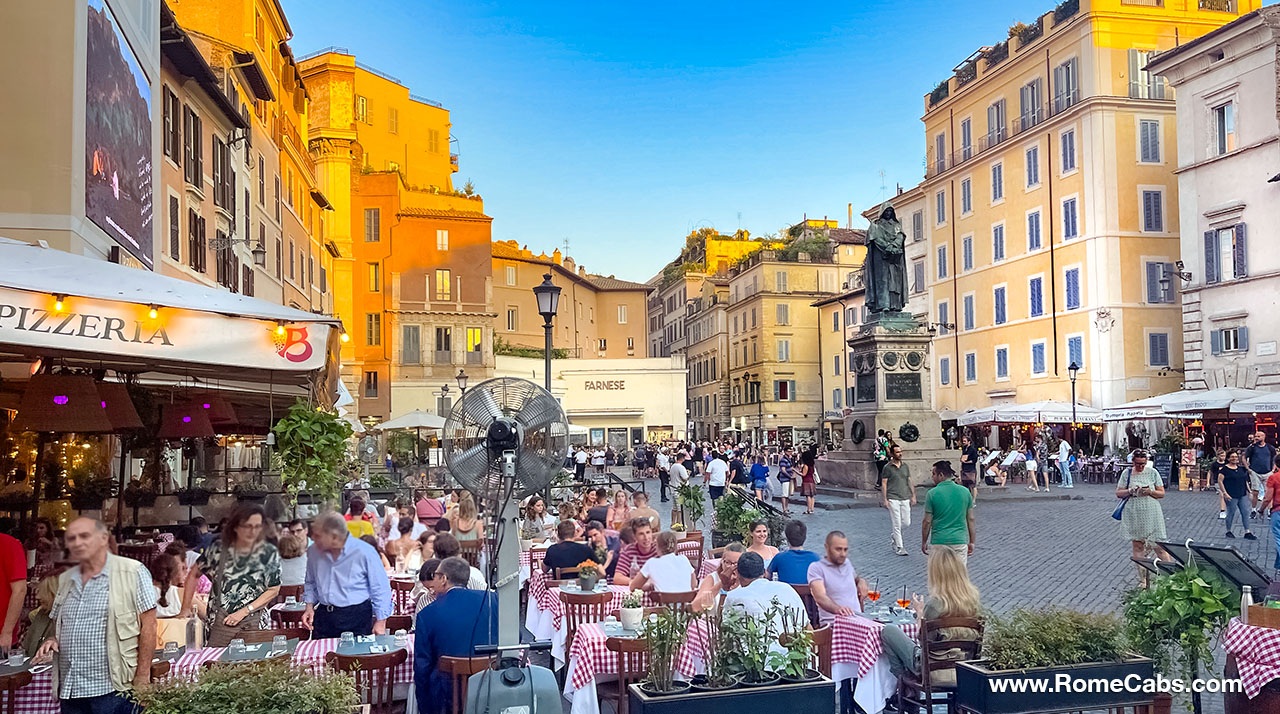
Cafés and Restaurants in Campo de' Fiori
Surrounding the square are charming cafés and trattorias, each offering a taste of traditional Roman cuisine. Visitors can indulge in classic dishes like pasta carbonara or enjoy a leisurely meal accompanied by a glass of local wine. The ambiance of these establishments is quintessentially Roman, with outdoor seating allowing patrons to soak in the lively atmosphere of Campo de' Fiori while savoring the culinary delights that define Roman gastronomy.
Campo de' Fiori's Daily Open-Air Market
At the heart of Campo de' Fiori is its bustling open-air market, a kaleidoscope of colors and scents that adds vibrancy to the square every day from Monday to Saturday. From early morning until afternoon, the market comes alive with stalls offering a feast for the senses—fresh produce, aromatic herbs, local cheeses, and vibrant flowers. This daily market tradition has deep roots in Roman culture, providing both locals and visitors with an opportunity to indulge in the finest ingredients and flavors the region has to offer.

Nightlife and Entertainment:
As the sun sets, Campo de' Fiori undergoes a metamorphosis, transitioning from a vibrant market square to a lively nightlife spot. The surrounding area comes alive with a myriad of options, from cozy wine bars to lively pubs. Locals and tourists gather to enjoy the evening atmosphere, sharing drinks, laughter, and live music. The square becomes a stage for street performers, adding an element of spontaneity to the nighttime revelry. Whether you're seeking a romantic evening or a lively gathering with friends, Campo de' Fiori offers an array of options to suit every taste.
7. St. Peter's Square (Piazza San Pietro)
No visit to Rome is complete without a pilgrimage to Vatican City, and at the heart of this sacred enclave lies St. Peter's Square. Designed by the eminent Gian Lorenzo Bernini, St. Peter's Square stands as a monumental entryway to the spiritual heart of Catholicism. The square is surrounded by a magnificent set of colonnades, consisting of four rows of Doric columns.
These columns, arranged in a grand elliptical shape, create a sense of embrace, symbolizing the maternal arms of the Church welcoming visitors from all corners of the world. The colonnades, with their 284 columns and 88 pillars, create a sense of unity and harmony, fostering a profound connection between the faithful and the sacred space.
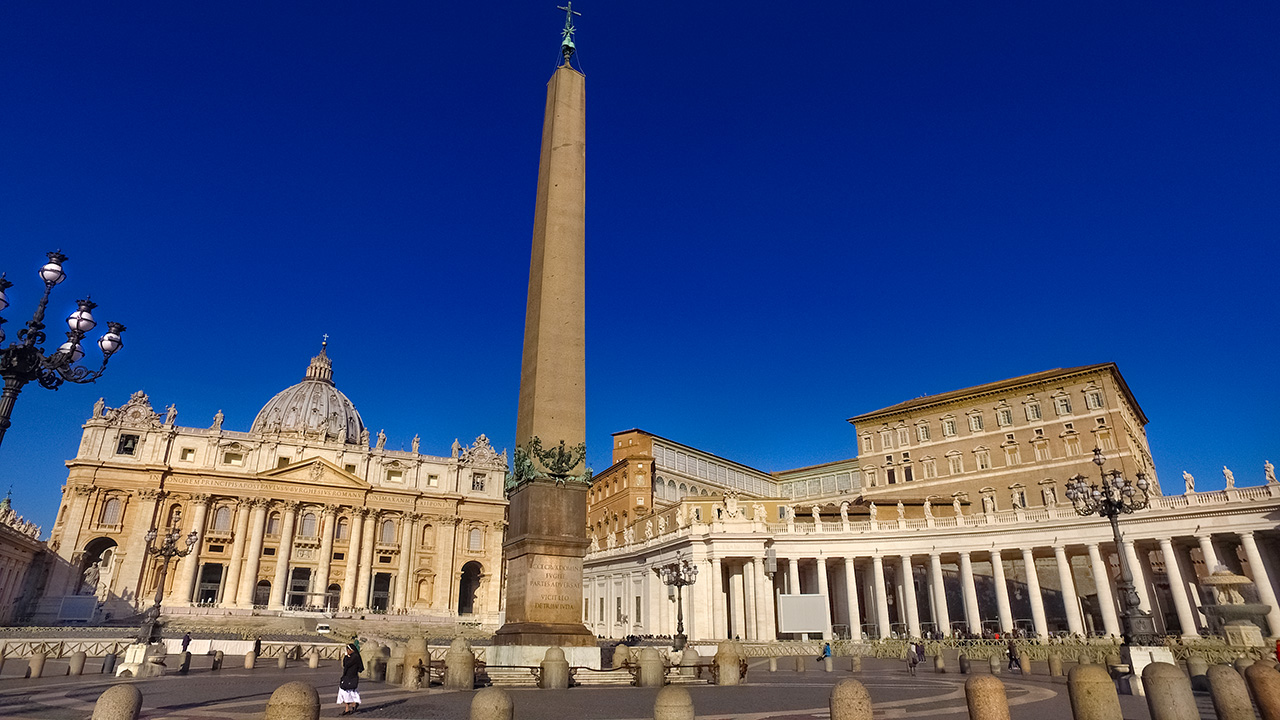
St. Peter's Basilica
Dominating the backdrop of St. Peter's Square is the majestic St. Peter's Basilica, one of the largest and most renowned churches in the world. With designs by Michelangelo, Gian Lorenzo Bernini, and others, contributing to its construction, the basilica is a sublime example of Renaissance and Baroque architecture. The square acts as a forecourt to this architectural marvel, serving as a space for congregations during important events and gatherings. The basilica's iconic dome, towering over the square, adds to the awe-inspiring panorama, creating a visual symphony of spirituality and artistic brilliance.
Twin Fountains of St. Peter's Square
As visitors approach the grandeur of St. Peter's Square, their eyes are drawn to two elegant fountains located on either side of the obelisk. These fountains, designed by Carlo Maderno and Gian Lorenzo Bernini, contribute to the square's aesthetic charm. The fountains not only serve as decorative elements but also play a practical role in providing a refreshing oasis for pilgrims and tourists alike. The water's gentle flow adds a soothing quality to the atmosphere, enhancing the overall experience of the square as a place for reflection and contemplation.
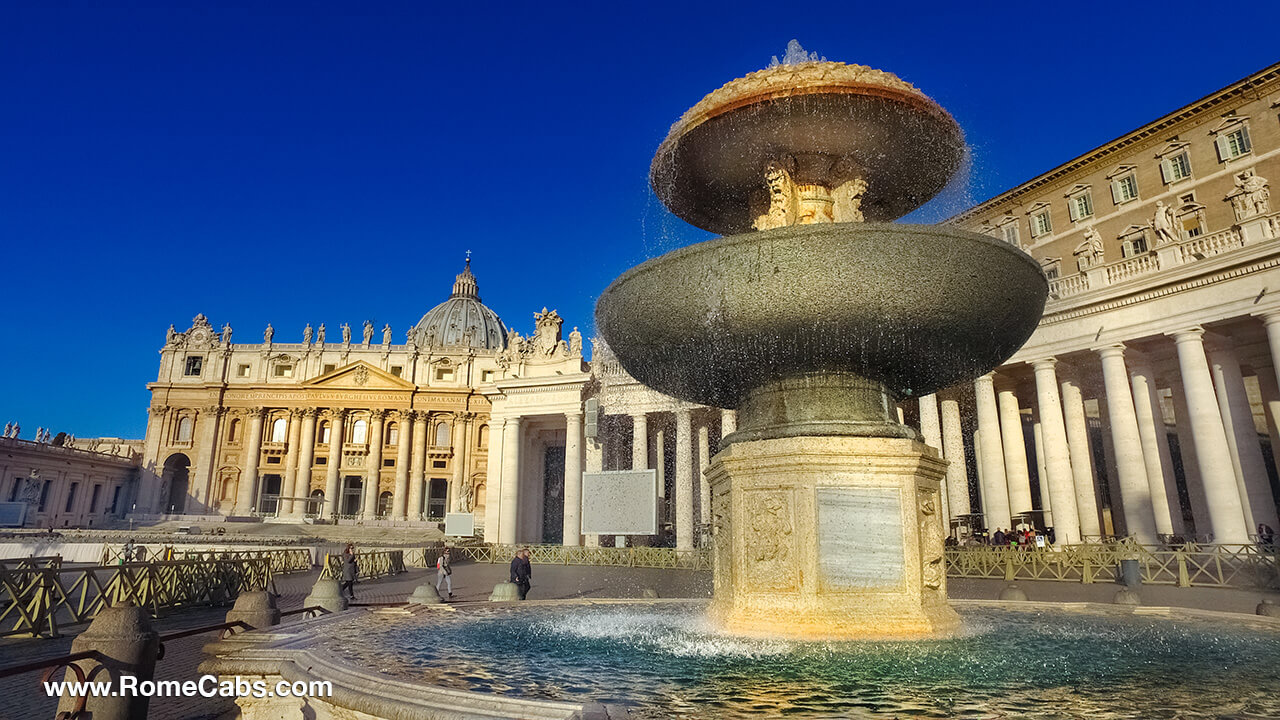
Egyptian Obelisk in St. Peter's Square
At the heart of St. Peter's Square stands a towering Egyptian obelisk, an ancient symbol of power and spirituality. This obelisk, originally erected in Heliopolis, Egypt, was transported to Rome by Emperor Caligula in 37 AD and later moved to its current location by Pope Sixtus V in 1586. The obelisk serves as a focal point, drawing the eyes skyward and adding a sense of verticality to the square's expansive horizontality. Its presence not only contributes to the aesthetics but also carries layers of historical and symbolic significance, connecting the square to ancient civilizations and the enduring legacy of the Catholic Church.
Bernini’s Illusion in St Peter's Square
The genius of Gian Lorenzo Bernini's design for St. Peter's Square goes beyond its sheer grandeur; it incorporates a remarkable optical illusion that enchants visitors when they stand at a specific point in the square. This architectural marvel, known as a "forced perspective", creates a visual illusion where all the columns seemingly align to form a single, perfectly straight line.
As you approach the square, the four rows of columns that comprise the colonnades appear to converge, giving the impression that they are part of a single, continuous structure. The specific spot, carefully calculated by Bernini, is marked by a circular stone in the middle of the square. Standing on this designated point, one can witness the magic of the forced perspective as the columns visually merge into a harmonious unity.
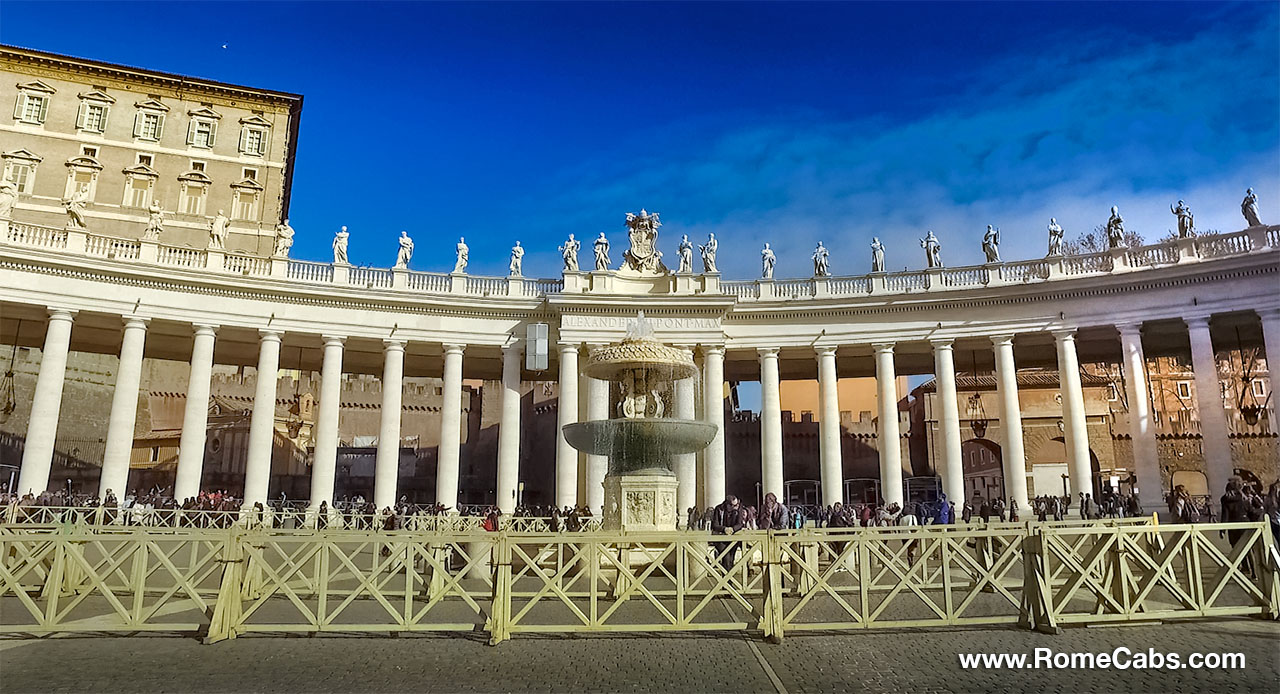
Rome's squares are not just open spaces; they are living canvases that tell the tale of a city rich in history, culture, and art. Exploring these must-see squares offers a glimpse into the soul of the Eternal City, where the past and present seamlessly intertwine, creating an unforgettable experience for every visitor. So, lace up your walking shoes, grab a map, and let the enchanting squares of Rome guide you through centuries of history and beauty.
Thank you for reading our travel blog the 7 Must-See Iconic Squares in Rome and for choosing RomeCabs for your private tours in Italy. We invite you to browse our collection of Rome tours and Shore Excursions from Civitavecchia and explore the marvels of the Eternal City and its iconic squares. We look forward to showing you beautiful places in Italy!
* Find us online also on:
- RomeCabs FACEBOOK
- RomeCabs PINTEREST
- RomeCabs TWITTER
- RomeCabs INSTAGRAM
- RomeCabs FLICKR Photo Gallery
- RomeCabs Recommended on Cruise Critic
- More RomeCabs blogs: https://rome-cabs.org/
